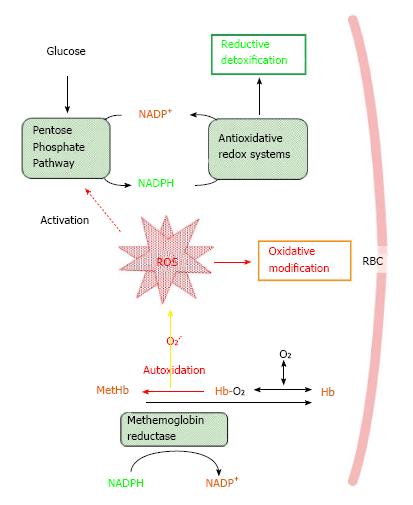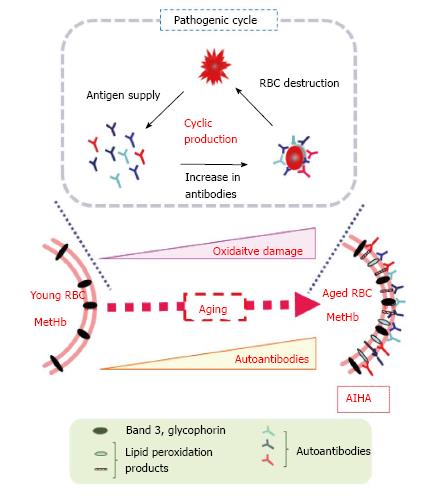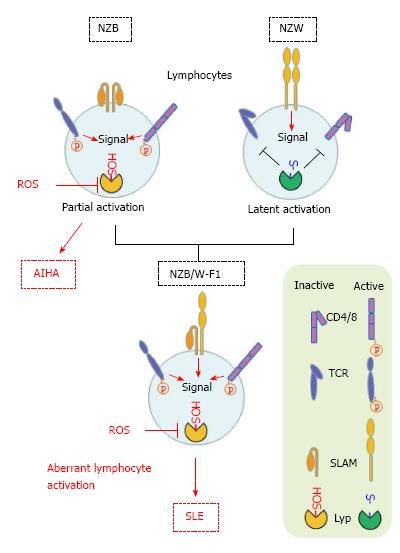Copyright
©The Author(s) 2015.
World J Nephrol. May 6, 2015; 4(2): 213-222
Published online May 6, 2015. doi: 10.5527/wjn.v4.i2.213
Published online May 6, 2015. doi: 10.5527/wjn.v4.i2.213
Figure 1 Oxidative stress and antioxidative/redox systems in red blood cells.
A part of oxygenized hemoglobin (Hb-O2) is autoxidized to methemoglobin (MetHb) and releases superoxide (O2-.), which may cause oxidative damage to RBCs. MetHb can be reduced back to Hb by methemoglobin reductase in NADPH-dependent manner. G6PD, a rate-determining enzyme in the pentose phosphate pathway, is involved in the production of NADPH that supports antioxid/redox systems as well as methemoglobin reduction by donating redox potential. G6PD deficiency affects entire antioxidative/redox systems, which can consequently accelerate the destruction of RBCs and lead to anemia. RBCs: Red blood cells. NADPH: Triphosphopyridine nucleotide.
Figure 2 Hypothetical role of oxidative stress in triggering the autoimmune reaction against red blood cells in New Zealand Black mice.
Elevated ROS trigger oxidative modification of RBC components and result in the production of oxidatively modified compounds such as 4-hydroxy 2-nonenal and acrolein that are highly antigenic. During aging, the oxidation of susceptible molecules and the production of antibodies recognizing them occurs repeatedly, which results in an accumulation of epitopes and autoantibodies. The elevated levels of autoantibodies ultimately trigger AIHA in aged NZB mice. RBCs: Red blood cells; AIHA: Autoimmune hemolytic anemia; MetHb: Methemoglobin; NZB: New Zealand Black; ROS: Reactive oxygen species.
Figure 3 Hypothetical model for triggering systemic lupus erythematosus in (NZB x NZW) F1 mice.
Lyp/pep suppressively regulates lymphocyte receptors such as CD4/8 and TCR. Production of ROS are originally high in the cells derived from NZB mice and oxidize the sulfhydryl group in the catalytic Cys to sulfenic acid (-SOH). So that Lyp/pep proteins in lymphocytes in the F1 mice are prone to oxidative inactivation. On the other hand, lymphocytes in NZW mice possess the variant form of SLAM that would be responsible for sustained activation of the lymphocytes. (NZB x NZW) F1 mice inherit this potentially pathogenic nature from parental strains. SLE: Systemic lupus erythematosus; ROS: Reactive oxygen species; NZB: New Zealand black; TCR: T-cell receptor; AIHA: Autoimmune hemolytic anemia.
- Citation: Fujii J, Kurahashi T, Konno T, Homma T, Iuchi Y. Oxidative stress as a potential causal factor for autoimmune hemolytic anemia and systemic lupus erythematosus. World J Nephrol 2015; 4(2): 213-222
- URL: https://www.wjgnet.com/2220-6124/full/v4/i2/213.htm
- DOI: https://dx.doi.org/10.5527/wjn.v4.i2.213











